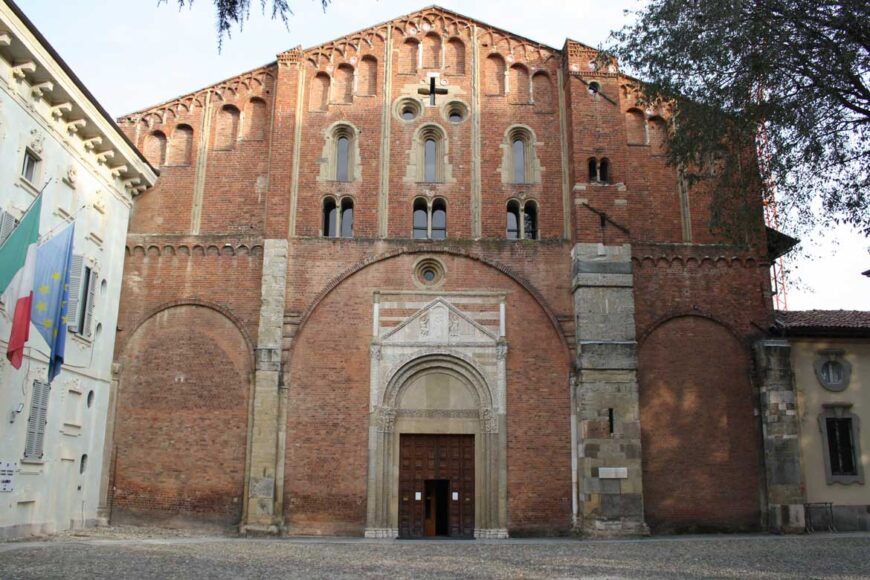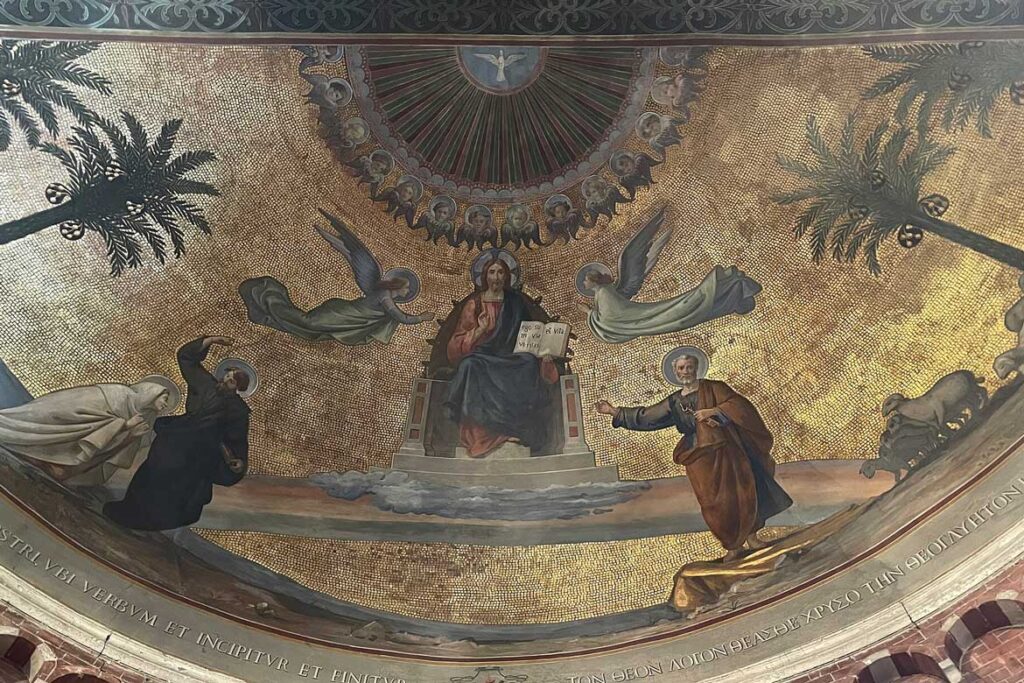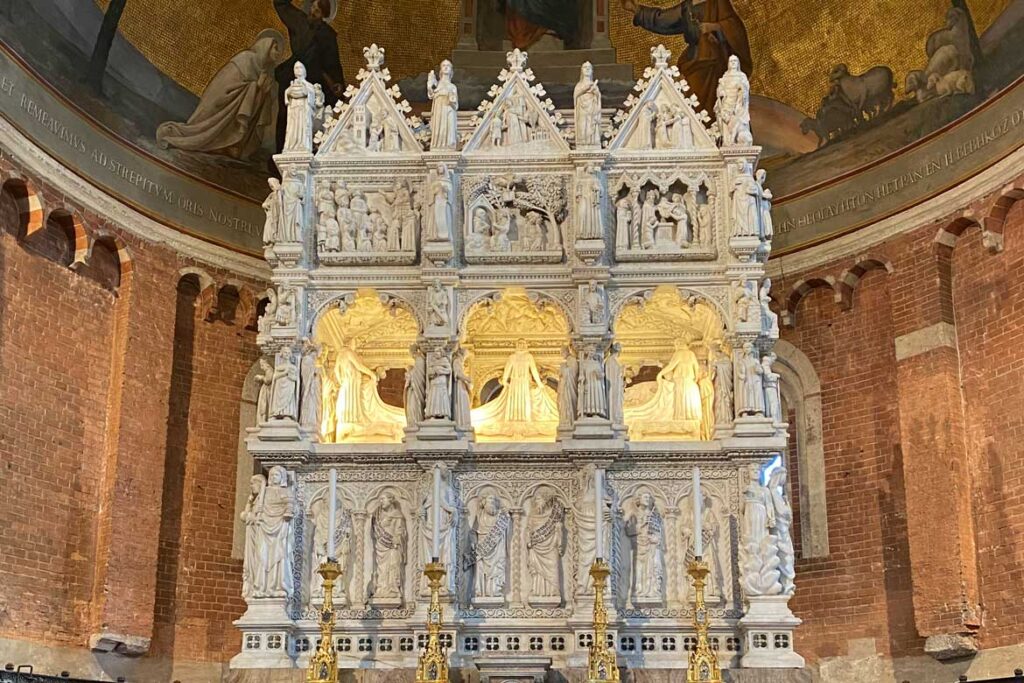San Pietro in Ciel d’Oro: A Hidden Gem in Pavia

San Pietro in Ciel d’Oro, or Saint Peter in the Golden Sky, is a stunning Catholic basilica located in Pavia, Italy. Known for its rich history and architectural beauty, this basilica is a must-visit for anyone exploring the Lombardy region. The basilica takes its name from the gilded dome inside the original sixth century structure, and is echoed in the stunning mosaics of gold leaf behind glass tesserae that adorn the ceiling of the apse in the present twelfth century church.
It is mentioned by Dante in the Divine Comedy (Paradiso – Canto X vv. 124-128) as the sacred repository of the remains of Boethius and by Petrarch in a letter to Giovanni Boccaccio (Seniles, V, 1). It also appears in one of the last stories of Boccaccio’s Decameron (Torello and Saladin, Novella IX, Day X).

History of the Church
The church’s history dates back to at least 604, when a church dedicated to Saint Peter was first recorded in Pavia. Tradition claims it was constructed on the spot where the Boethius was executed in 524.
The basilica underwent significant renovations between 720 and 725 under the reign of Liutprand, King of the Lombards, who is also buried there. The current Romanesque structure was consecrated by Pope Innocent II in 1132, following extensive renovations. The basilica’s architectural style and historical significance have made it a notable landmark in the region.
San Pietro in Ciel d’Oro is also renowned for housing the relics of Saint Augustine of Hippo. Augustine’s remains were moved to Pavia around 720 by Peter, bishop of Pavia, after being rescued from the Saracens in Sardinia. The basilica became a major pilgrimage site due to these relics, further enhancing its religious and cultural importance.
Throughout the centuries, the basilica has seen various restorations and changes. In the 19th century, it was reconstructed and reconsecrated in 1896, with the relics of Augustine and the shrine being reinstalled. Today, San Pietro in Ciel d’Oro stands as a testament to the rich history and enduring legacy of Pavia’s religious heritage.
The Grave of St. Augustine
The grave of Saint Augustine is a remarkable example of medieval Lombard sculpture. Known as the Arca di Sant’Agostino, this elaborate marble tomb was constructed in 1362 and is a masterpiece of Gothic art. The ark is elevated on a crypt and is adorned with intricate carvings and statues that depict various scenes from the life of Saint Augustine.
The construction of the ark is a testament to the craftsmanship of the period. It is made of white marble and features a series of relief panels that narrate key moments in Augustine’s life. These panels include depictions of his conversion, baptism, and the miracles attributed to him after his death. The ark is supported by columns and is topped with a canopy that adds to its grandeur.

The ornamentation of the ark is particularly noteworthy for its detailed relief panels. These panels are divided into several registers, each telling a different part of Augustine’s story. The uppermost panels illustrate scenes from his early life and conversion, while the middle panels focus on his theological contributions and his role as a bishop. The lower panels depict the transfer of his relics to Pavia and the miracles that occurred at his tomb.
One of the most striking features of the ark is the central panel, which shows Augustine’s conversion in the garden in Milan. This scene is rendered with great emotion and detail, capturing the moment of his spiritual awakening. Surrounding this central panel are smaller scenes that highlight other significant events, such as his baptism by Saint Ambrose and his ordination as a bishop.
The ark also includes numerous statues of saints and angels, which add to its overall splendor. These figures are carved with exquisite detail, showcasing the skill of the sculptors who created them. The combination of relief panels and statues makes the Arca di Sant’Agostino not only a significant religious artifact but also a stunning piece of art that continues to draw visitors and pilgrims to the basilica.
The Grave of Boethius
The grave of Boethius, is a significant historical and cultural site. Boethius, a renowned Roman philosopher, statesman, and theologian, was buried here after his execution in 524 AD. His tomb is situated in the crypt of the basilica, a place of reverence and pilgrimage for those who admire his contributions to philosophy and early medieval thought. The crypt itself is a serene and solemn space, reflecting the profound respect held for Boethius and his work.
The tomb is relatively simple compared to that of St. Augustine. It is marked by a stone slab with inscriptions that commemorate Boethius’s life and achievements. The modesty of the grave contrasts with the grandeur of the basilica above, yet it serves as a poignant reminder of Boethius’s enduring legacy. Visitors to the basilica often pay their respects at his tomb, reflecting on his influential work, The Consolation of Philosophy, which he wrote while imprisoned.
The Grave of Liutprand
The grave of Liutprand, King of the Lombards, is also found in the Basilica of San Pietro in Ciel d’Oro. Liutprand, who reigned from 712 to 744, is remembered for his significant contributions to Lombard law and his successful military campaigns. His tomb is a notable feature within the basilica, reflecting his importance in Lombard history.
The tomb itself is relatively modest compared to other royal burials, yet it holds great historical significance. It is marked by a simple stone slab with inscriptions that commemorate his reign and achievements. The location within the basilica underscores the respect and reverence held for Liutprand, who played a crucial role in the consolidation and expansion of the Lombard Kingdom.
